Seznam krajev Unescove svetovne dediščine v Italiji
Ta članek je za krajši čas rezerviran, saj ga namerava eden izmed sodelavcev v večji meri preurediti. Prosimo vas, da strani v tem času ne spreminjate, saj bi lahko prišlo do navzkrižja urejanj. Če je iz zgodovine strani razvidno, da je zadnjih nekaj dni ni spreminjal nihče, lahko to predlogo odstranite. |

Svetovna dediščina Organizacije Združenih narodov za izobraževanje, znanost in kulturo (UNESCO) je pomembna za kulturno ali naravno dediščino, kot je opisano v Unescovi konvenciji o svetovni dediščini, ustanovljeni leta 1972.[1] Kulturno dediščino sestavljajo spomeniki (kot so arhitekturna dela, monumentalne skulpture ali napisi), skupine zgradb in najdišča (vključno z arheološkimi najdišči). Naravne značilnosti (ki jih sestavljajo fizične in biološke formacije), geološke in fiziografske formacije (vključno s habitati ogroženih vrst živali in rastlin) ter naravna območja, ki so pomembna z vidika znanosti, ohranjanja ali naravne lepote, so opredeljena kot naravna dediščina.[2] Italija je konvencijo ratificirala 23. junija 1978.[3]
Od leta 2023 ima Italija 59 območij na seznamu, zaradi česar je država pogodbenica z največ območji svetovne dediščine, tik pred Kitajsko (57).[4] Prvo najdišče v Italiji, skalne risbe v Valcamonici, je bilo uvrščeno na seznam na 3. zasedanju Odbora za svetovno dediščino, ki je potekalo v Kairu in Luksorju v Egiptu leta 1979.[5] V 1990-ih je bilo dodanih 25 italijanskih območij, vključno z 10 območji, dodanih na 21. zasedanju v Neaplju leta 1997. Italija je bila petkrat članica Odbora za svetovno dediščino, 1978–1985, 1987–1993, 1993–1999 , 1999–2001 in 2021–2025.
Od 59 italijanskih dediščin jih je 53 kulturnih in 6 naravnih. Sedem lokacij je transnacionalnih. Zgodovinsko središče Rima si deli z Vatikanom; Monte San Giorgio in Retijska železnica s Švico; Beneške utrdbe iz 16. in 17. stoletja s Hrvaško in Črno goro; Prazgodovinska kolišča okoli Alp s 5 drugimi državami; Velika zdraviliška mesta Evrope s 6 drugimi državami; in Starodavni prvobitni bukovi gozdovi Karpatov in drugih delov Evrope si deli s 17 drugimi državami. Poleg tega ima Italija na poskusnem seznamu 31 območij.
Svetovna dediščina[uredi | uredi kodo]
Unesco navaja mesta pod desetimi merili; vsaka prijava mora izpolnjevati vsaj enega od kriterijev. Merila od i do vi so kulturna, od vii do x pa naravna.[6]
| Ime | Slika | Lokacija | Leto vpisa | UNESCO kriterij | Opis |
|---|---|---|---|---|---|
| Skalne poslikave v Val Camonici | 
|
Brescia | 1979 | 94; iii, vi (kulturno) | Valcamonica je dom ene največjih zbirk petroglifov na svetu. V dolini je v obdobju 8000 let od epipaleolitika do srednjega veka nastalo več kot 140.000 skalnih rezbarij. Upodabljajo prizore iz poljedelstva, navigacije, vojne in magije.[7][8] |
| Zgodovinsko središče Rima, lastnina Vatikana v tem mestu z ekstrateritorialnimi pravicami in Bazilika sv. Pavla zunaj obzidja*} | 
|
Metropolitansko mesto glavnega mesta Rim, Vatikan | 1980, 1990, 2015 | 91ter; i, ii, iii, iv, vi (kulturno) | Mesto Rim je bilo središče Rimskega cesarstva, kasneje pa tudi krščanskega sveta. Je dom velikega števila pomembnih spomenikov antike, vključno s Kolosejem (na sliki), Panteonom in rimskim forumom, pa tudi stavbami iz renesančnega in baročnega obdobja. Prvotno navedeno kot zgodovinsko središče Rima, je bilo leta 1990 razširjeno in preimenovano v sedanje ime. Leta 2015 je prišlo do druge spremembe meje. Mesto si deli z Vatikanom.[9] |
| Cerkev in dominikanski samostan Santa Maria delle Grazie z Zadnjo večerjo Leonarda da Vincija | 
|
Metropolitansko mesto Milano | 1980 | 93; i, ii (kulturno) | Kompleks dominikanskega samostana v Milanu je bil zgrajen v drugi polovici 15. stoletja; delno se pripisuje Bramanteju. Na severni steni refektorija samostana je stenska slika Zadnja večerja Leonarda da Vincija, mojstrovina umetnosti visoke renesanse.[10] |
| Zgodovinsko središče Firenc | 
|
Metropolitansko mesto Firence | 1982, 2015, 2021 | 174ter; i, ii, iii, iv, vi (kulturno) | Mesto Firence je simbol renesanse in je bilo pomembno središče renesančnega humanizma. Imelo je velik vpliv na arhitekturo in umetnost Italije in Evrope, saj je bilo povezano z umetniki, kot so Giotto, Brunelleschi, Botticelli in Michelangelo. Spomeniki v mestu so Firenška stolnica, bazilika sv. Križa, galerija Uffizi in Palača Pitti. V letih 2015 in 2021 je prišlo do manjših sprememb meja mesta. Na sliki je Piazza della Signoria.[11] |
| Benetke in njihova laguna | 
|
Metropolitansko mesto Benetke | 1987 | 394; i, ii, iii, iv, v, vi (kulturno) | Mesto Benetke je bilo ustanovljeno v 5. stoletju in se je v 10. stoletju razvilo v veliko pomorsko silo, Beneško republiko. Zgrajeno je na več kot 100 otokih v laguni in vsebuje spomenike, kot so bazilika svetega Marka, Doževa palača ter številne cerkve in mostovi. Tudi po padcu politične moči so Benetke ostale vplivne na področju umetnosti z inovacijami slikarjev Bellinija, Giorgioneja, Tiziana, Tintoretta, Veroneseja in Tiepola. Benetke povezujejo tudi z raziskovalcem Marcom Polom iz 13. stoletja.[12] |
| Piazza del Duomo, Pisa | 
|
Pisa | 1987, 2007 | 395bis; i, ii, iv, vi (kulturno) | Piazza dei Miracoli je eden najlepših srednjeveških arhitekturnih kompleksov na svetu in obsega štiri mojstrovine iz 11. do 14. stoletja: stolnico, krstilnico, pokopališče in poševni stolp. Pisanski romanski slog, ki se je razvil tukaj, je bil vpliven v drugih toskanskih mestih. Kompleks je povezan tudi z Galileom Galilejem, ki je tam izvajal svoje poskuse. Leta 2007 je prišlo do manjše spremembe meje.[13][14] |
| Zgodovinski center San Gimignano | 
|
Siena | 1990 | 550; i, iii, iv (kulturno) | Mesto San Gimignano je bilo v srednjem veku pomembna postojanka za romarje na Via Francigena. Mesto ohranja svoj srednjeveški značaj, njegova najpomembnejša značilnost pa so visoki stolpi, ki so jih med 11. in 13. stoletjem zgradile plemiške družine in trgovci višjega srednjega razreda. Štirinajst teh stolpov se je ohranilo do danes. Cerkve in palače v mestu so dom številnih mojstrovin umetnikov iz 14. in 15. stoletja.[15] |
| Jamska bivališča Sassi di Matera in park rupeštskih cerkva Matera | 
|
Matera (pokrajina) | 1993 | 670; iii, iv, v (kulturno) | To območje obsega dve okrožji Matere z jamskimi bivališči, ki so bila prvič naseljena v paleolitiku. Ljudje so naselili naravne jame na kraški planoti Murge in kasneje začeli klesati in graditi zahtevnejše objekte, vključno s cerkvami in samostani. Romanska stolnica je iz 13. stoletja.[16] |
| Mesto Vicenza in Palladijeve vile v Benečiji | 
|
Padova (pokrajina), Rovigo (pokrajina), Treviso (pokrajina), Metropolitansko mesto Benetke, Verona (pokrajina), Vicenza (pokrajina) | 1994, 1996 | 712; i, ii (kulturno) | V 16. stoletju, ko je bila pod Beneško republiko, je arhitekt Andrea Palladio (1508–80) zgradil več vil v mestu Vicenza in okoliški deželi Benečija. Njegovi načrti so močno vplivali na arhitekturo in navdihnili paladijevski slog. Dediščina, ki je bila leta 1994 prvotno navedena kot Vicenza, Palladijevo mesto, je bilo leta 1996 razširjeno in vključuje več vil v regiji. Na sliki je Vila Chiericati.[17][18] |
| Staro mestno jedro Siene | 
|
Siena (pokrajina) | 1995 | 717; i, ii, iv (kulturno) | Mesto Siena je ohranilo svoj srednjeveški gotski značaj od 12. do 15. stoletja. Mesto je zgrajeno okoli trga Piazza del Campo. Več pomembnih renesančnih slikarjev je delalo in se rodilo v Sieni, med njimi Duccio, Ambrogio Lorenzetti in Simone Martini. Na sliki Sienska stolnica.[19] |
| Staro mestno jedro Neaplja | 
|
Metropolitansko mesto Neapelj | 1995 | 726bis; ii, iv (kulturno) | Neapelj, ki so ga leta 470 pred našim štetjem ustanovili grški kolonisti, je bil eno najpomembnejših mest Magna Graecia, Rimske republike, in glavno mesto Neapeljskega kraljestva pod več kraljevimi hišami. Imel je velik vpliv na evropsko umetnost in arhitekturo. Nekateri pomembni spomeniki so cerkev Santa Chiara iz 14. stoletja, Castel Nuovo iz 13. stoletja (na sliki) in kraljeva palača iz 17. stoletja. Leta 2011 je prišlo do manjše spremembe meje.[20] |
| Industrijsko delavsko naselje Crespi d'Adda | 
|
Bergamo (pokrajina) | 1995 | 730; iv, v (kulturno) | Crespi d'Adda je dobro ohranjeno poslovno mesto, zgrajeno v 19. in 20. stoletju za delavce tekstilnega proizvajalca Cristofora Crespija. Mesto vključuje tako stanovanjske stavbe kot skupne javne storitve, kot so ambulanta, šola, gledališče in športni center. Nekatere stavbe so še v uporabi.[21] |
| Ferrara, renesančno mesto in delta Pada | 
|
Ferrara | 1995, 1999 | 733bis; ii, iii, iv, v, vi (kulturno) | Ferrara, sedež rodbine Este, je bila med italijansko renesanso 15. in 16. stoletja intelektualno in umetniško središče. Pritegnila je umetnike, da so okrasili več dvorcev in palač (na sliki Estejev grad), medtem ko je arhitekturna šola vplivala na sloge v Italiji in Evropi. Prvotno navedeno kot Ferrara, mesto renesanse, je bilo leta 1999 razširjeno na kulturno krajino delte reke Pad.[22][23] |
| Castel del Monte | 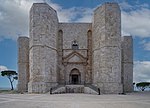
|
Barletta-Andria-Trani | 1996 | 398rev; i, ii, iii (kulturno) | Osmerokotni grad je v 13. stoletju zgradil cesar Friderik II. Hohenstaufen. Združuje severnoevropsko cistercijansko gotiko, muslimansko arhitekturo in elemente klasične antike v popolnoma simetrični zasnovi.[24] |
| Trulli v Alberobello | 
|
Bari (pokrajina) | 1996 | 787; iii, iv, v (kulturno) | Trulli so tradicionalne koče iz apnenca, značilne za deželo Apulija. Gradili so jih vsaj od sredine 14. stoletja v prazgodovinski tehniki suhih zidov, običajno s stožčastimi, kupolastimi ali piramidastimi strehami iz kamnitih plošč z zavihki. Na seznamu svetovne dediščine so trulli v mestu Alberobello z več kot 1500 ohranjenimi stavbami.[25] |
| Zgodnjekrščanski spomeniki v Raveni | 
|
Ravena (pokrajina) | 1996 | 788; i, ii, iii, iv (kulturno) | To mesto obsega osem spomenikov v mestu Ravena, ki je bilo sedež Rimskega cesarstva v 5. stoletju. Cerkve in mavzoleje krasijo mozaiki izjemne umetniške kakovosti, ki prepletajo motive zahodne in bizantinske umetnosti. Na sliki je bazilika San Vitale.[26] |
| Staro mestno jedro Pienze | 
|
Siena (pokrajina) | 1996 | 789; i, ii, iv (kulturno) | Leta 1459 se je papež Pij II. odločil preoblikovati svoje rojstno mesto Pienza v skladu z renesančnimi humanističnimi idejami urbanističnega oblikovanja. Projekt je nadziral arhitekt Bernardo Rossellino, ki je zgradil nove trge, cerkve in palače. Pienza je bila kasneje model urbanega razvoja v drugih italijanskih in evropskih mestih.[27] |
| Caserta in San Leucio | 
|
Caserta (pokrajina) in Benevento (pokrajina) | 1997 | 549rev; i, ii, iii, iv (kulturno) | Ta obsežen kompleks palač je sredi 18. stoletja naročil neapeljski kralj Bourbonov Karel III. Španski Zasnoval ga je arhitekt Luigi Vanvitelli po navdihu palač v Versaillesu in Madridu. Po zamislih razsvetljenstva je kompleks dobro vpet v krajino. Mesto vključuje akvadukt in industrijski kompleks San Leucio, kjer so proizvajali svilo.[28] |
| Rezidence kraljeve družine Savojcev | 
|
Metropolitan City of Turin, Cuneo | 1997 | 823bis; i, ii, iv, v (kulturno) | This site comprises 22 palaces and villas constructed to demonstrate the power of the ruling monarchy following the move of the capital of the House of Savoy to Turin by Emmanuel Philibert in 1562. The buildings, mostly in Baroque style, are representative of 17th and 18th century European monumental architecture. A minor boundary modification took place in 2010. The Palazzina di caccia of Stupinigi is pictured.[29][30] |
| Botanični vrt v Padovi | 
|
Padua | 1997 | 824; ii, iii (kulturno) | Padua's botanical garden was founded in 1545 as the world's first university botanical garden. It has been a centre of scientific research for centuries, as well as a template for other gardens. It was renovated in the 18th century but still retains its original layout.[31] |
| Porto Venere in Cinque Terre | 
|
La Spezia | 1997 | 826bis; ii, iv, v (kulturno) | The cultural landscape along the Ligurian coast has been shaped by humans over the past millennium. There are several scenic small towns built among the steep rugged terrain, and the land has been converted to terraces. There are also three islands off the coast with remains of early monastic buildings. A minor boundary modification took place in 2021. A church in Porto Venere is pictured.[32] |
| Stolnica, stolp Ghirlandina in Piazza Grande, Modena | 
|
Modena | 1997 | 827; i, ii, iii, iv (kulturno) | The 12th-century complex, comprising the cathedral, the tower, and the square, is an excellent example of early Romanesque art, with strong influence on the development of the style. The cathedral was designed by the architect Lanfranco and decorated by the sculptor Wiligelmo.[33] |
| Pompeiji, Herkulanej in Torre Annunziata | 
|
Metropolitan City of Naples | 1997 | 829; iii, iv, v (kulturno) | This site comprises three sites that were buried under volcanic ash during the eruption of Mount Vesuvius in 79 CE. The towns of Pompeii and Herculaneum are two Roman towns that have been preserved completely and provide insight into the life in the 1st century CE while the two villas at Torre Annunziata have well preserved wall paintings. The sites have been progressively excavated since the mid-18th century.[34] |
| Obala v Amalfiju (Costiera Amalfitana) | 
|
Salerno | 1997 | 830; ii, iv, v (kulturno) | The Mediterranean cultural landscape of the Amalfi Coast was shaped prominently during the time of the medieval Duchy of Amalfi (from the 9th to 11th century) in a mixture of Western and Byzantine influences. The coast includes towns, such as Amalfi and Ravello, as well as vineyards, orchards, and pastures, at the point where the mountains are touching the sea.[35] |
| Dolina templjev v Agrigento | 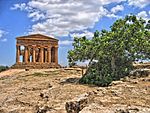
|
Agrigento | 1997 | 831; i, ii, iii, iv (kulturno) | Agrigento, a Greek colony founded in the 6th century BCE, developed into one of the major cities of Magna Graecia and of the Mediterranean. Several Doric temples have been preserved, and they represent one of the most notable sites of Greek art and culture.[36] |
| Villa Romana del Casale | 
|
Enna | 1997 | 832; i, ii, iii (kulturno) | The villa in Piazza Armerina is one of the most luxurious Roman villas built in the early 4th century, and is a representative example of the economy and social structure of its period. It is richly decorated with mosaics of exceptional quality, it represents the finest in situ collection of Roman mosaics in the world.[37] |
| Arheološko najdišče Su Nuraxi di Barumini | 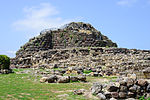
|
South Sardinia | 1997 | 833; i, iii, iv (kulturno) | Su Nuraxi is the finest and the most complete example of nuraghe, a defensive megalithic structure of the Bronze Age Nuragic civilization of the 2nd millennium BCE. Unique to Sardinia, nuraghi are circular defensive towers in the form of truncated cones with internal chambers. The one at Su Nuraxi was originally over 185 m (607 ft) high. The site was abandoned in the 6th century BCE and most nuraghi went out of use after Roman colonization in the 2nd century BCE.[38] |
| Arheološka najdišča in patriarhova bazilika v Ogleju | 
|
Udine | 1998 | 825ter; iii, iv, vi (kulturno) | Aquileia was one of the wealthiest cities of the early Roman Empire. In 452, it was sacked by the Huns under Attila; most of the ancient city now remains preserved and unexcavated. The Patriarchal Basilica, with its mosaic floors, dates to the 4th century. It was rebuilt between the 11th and 14th centuries. It played a major role in the spreading of Christianity to a large part of Central Europe in the early Middle Ages. Minor boundary modifications took place in 2017 and 2018.[39] |
| Historic Centre of Urbino | 
|
Pesaro and Urbino | 1998 | 828; ii, iv (kulturno) | In the 15th century, Urbino flourished under the leadership of Federico da Montefeltro, a humanist who attracted some of the most prominent scientists and artists to the city. The city's Renaissance architecture has been largely preserved as Urbino entered cultural and economic stagnation from the 16th century onward.[40] |
| Narodni park Cilento in Vallo di Diano z arheološkima najdiščema Paestum in Velia ter Certosa di Padula | 
|
Salerno | 1998 | 842; iii, iv (kulturno) | The cultural landscape was shaped by different societies through centuries, including Etruscans, Lucanians, Greek colonists, and later Romans. The site includes the remains of Paestum and Velia, two major towns from classical times. The Carthusian monastery Certosa di Padula dates to 1306, although most of the present buildings are from the 17th and 18th centuries in the Baroque style.[41] |
| Hadrijanova vila v Tivoliju | 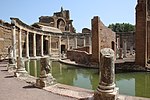
|
Metropolitan City of Rome Capital | 1999 | 907; i, ii, iii (kulturno) | Villa Adriana or "Hadrian's Villa" in Tivoli, outside Rome, was built in the 2nd century CE as a retreat for the Emperor Hadrian. It combines architectural elements from Greece, Egypt, and Rome. The complex includes residential and recreational buildings, gardens, and pools. Its rediscovery in the mid-15th century influenced the architects of the Renaissance and Baroque periods.[42] |
| Staro mestno jedro Verone | 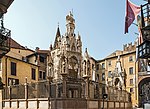
|
Verona | 2000 | 797rev; ii, iv (kulturno) | Verona, founded as a Roman town in the 1st century BCE, has developed uninterruptedly for over 2,000 years and preserves urban structures and monuments from different periods. They include the Roman amphiteatre and Roman gate, the Gothic Scaliger Tombs (pictured), as well as several historic squares and palaces.[43] |
| Liparski otoki (Eolsko otočje) | 
|
Messina | 2000 | 908; viii (naravno) | This archipelago off the coast of Sicily has been extensively studied by geologists at least since the 18th century. The islands contain several classical features of volcanic landforms, which were important in the development of volcanology as a scientific discipline. Two types of volcanic eruptions bear names after the islands of the archipelago, Strombolian and Vulcanian.[44] |
| Bazilika in spomeniki sv. Fračiška v Assisiju | 
|
Perugia | 2000 | 990; i, ii, iii, iv, vi (kulturno) | Assisi was the birthplace of Saint Francis, founder of the Franciscan order. The Basilica was built in the 13th century. It features paintings by Cimabue, Pietro Lorenzetti, Simone Martini, and Giotto, and has been a reference point for Italian and Western art.[45] |
| Villa d'Este, Tivoli | 
|
Metropolitan City of Rome Capital | 2001 | 1025; i, ii, iii, iv, vi (kulturno) | The 16th century-gardens of Vila d'Este are one of the first and best examples of Italian Renaissance gardens. The gardens have a geometric layout in line with Renaissance aesthetics and are decorated with pools and fountains, designed by Pirro Ligorio. They had a large influence on European garden design.[46] |
| Poznobaročna mesta v Val di Noto (JV Sicilija) | 
|
Catania, Ragusa, Syracuse | 2002 | 1024; i, ii, iv, v (kulturno) | In 1693, a powerful earthquake hit Sicily, destroying several towns and cities. In the aftermath, the towns of Caltagirone, Militello Val di Catania, Catania, Modica, Noto, Palazzolo, Ragusa, and Scicli were rebuilt in line with the Baroque urban planning trends. They represent the pinnacle of late Baroque art in Europe.[47] |
| Sacri Monti of Piedmont and Lombardy | 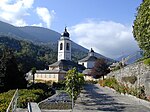
|
several sites | 2003 | 1068rev; ii, iv (kulturno) | The phenomena of Sacri Monti (Sacred Mountains) began at the end of the 15th century with an aim of creating alternative pilgrimage and prayer sites due to inaccessibility of the Holy Land. The site comprises nine such complexes in Piedmont and Lombardy built in the late 16th and 17th centuries. They are rich in arts and are well integrated into the landscape. The Sacred Mount Calvary of Domodossola is pictured.[48] |
| Dolina Val d'Orcia | 
|
Siena | 2004 | 1026rev; iv, vi (kulturno) | The cultural landscape of Val d'Orcia in the hinterland of Siena was carefully redesigned during the 14th and 15th century in line with the Renaissance aesthetical ideals. The landscape consists of small villages, towns, fields, pastures, meadows, and small farms. It has featured prominently on the paintings of the Sienese School.[49] |
| Etruščanski nekropoli Cerveteri in Tarkvinija | 
|
Viterbo, Metropolitan City of Rome Capital | 2004 | 1158; i, iii, iv (kulturno) | Cerveteri and Tarquinia are two Etruscan cemeteries from the 9th to the 1st century BCE. Several tombs that were designed as replicas of Etruscan houses are decorated with outstanding wall paintings depicting scenes of daily life (the Tomb of the Leopards pictured).[50] |
| Sirakuze in skalna nekropola Pantalika | 
|
Syracuse | 2005 | 1200; ii, iii, iv, vi (kulturno) | Syracuse was founded in the 8th century BCE by the Corinthians and became one of the most important cities of Magna Graecia. An important monument from this period is the Doric Temple of Apollo. The Necropolis of Pantalica (pictured) contains more than 5,000 tombs, most dating from the 13th to the 7th centuries BCE, and remains of Byzantine era structures.[51] |
| Strade Nuove in Palazzi dei Rolli v Genovi | 
|
Metropolitan City of Genoa | 2006 | 1211; ii, iv (kulturno) | This site comprises two urban developments in Genoa from the 16th and 17th centuries, when the Republic of Genoa was at the peak of its power. Le Strade Nuove (New Streets) are a group of streets (including Via Giuseppe Garibaldi) built by the Genoese aristocracy. The Palazzi dei Rolli (Palaces of the Lists) are a group of Renaissance and Baroque palaces which were associated to a particular system of public lodging in private residences, whereby notable guests on State visit to the Republic were hosted in one of these palaces on behalf of the State. Palazzo Cattaneo Belimbau is pictured.[52] |
| Retijska železnica v pokrajinah Albula / Bernina* | 
|
Sondrio | 2008 | 1276; ii, iv (kulturno) | The Albula and Bernina lines of the Rhaetian Railway are two historic railway lines that cross the Swiss Alps. They were built in the early 20th century, providing a rapid and easy route into many formerly isolated alpine settlements. Building the railroads required overcoming technical challenges with bridges, galleries, and tunnels. The site is shared with Switzerland. The train station in Tirano is pictured.[53] |
| Mantova in Sabbioneta | 
|
Mantua | 2008 | 1287; ii, iii (kulturno) | These two towns represent two approaches of Renaissance period town planning. Mantua (pictured), originating in Roman times and preserving structures from the 11th century, was renovated in the 15th and 16th centuries. On the other hand, Sabbioneta was founded in the second half of the 16th century by Vespasiano I Gonzaga and built with a grid plan, according to the period's vision of an ideal city.[54] |
| Dolomiti | 
|
several sites | 2009 | 1237rev; vii, viii (naravno) | This site comprises nine areas of the Dolomites, a mountain range in the northern Italian Alps. There are 18 peaks above 3.000 m (9.800 ft), with mountain scenery including sheer rocky cliffs, vertical walls, long and narrow valleys. From the geological perspective, the rocks contain fossils record of marine life in the Triassic period. Marmolada is pictured.[55] |
| Monte San Giorgio* | 
|
Varese | 2010 | 1090; viii (naravno) | Monte San Giorgio, overlooking Lake Lugano, preserves the best fossil record of marine life from the Triassic Period (245–230 million years ago). In that period, the area was a tropical lagoon, flourishing with reptiles, fish, bivalves, ammonites, echinoderms, and crustaceans. Fossils of terrestrial animals are also preserved. The part of the property in Switzerland was listed in 2003 and expanded to include the Italian part in 2010.[56] |
| Središča oblasti Langobardov | 
|
several sites | 2011 | 1318; ii, iii, vi (kulturno) | This site comprises seven groups of monasteries, churches, and fortresses associated with the Longobards who ruled in Italy from the 6th to the 8th century. The arts and architecture reflect the synthesis of Roman, Christian, and Germanic influences. The monuments listed are located in Brescia, Cividale del Friuli (artwork in the Oratorio di Santa Maria in Valle pictured), Castelseprio, Spoleto, Campello sul Clitunno, Benevento, and Monte Sant'Angelo. Its architecture marks a synthesis of various styles and the transition to the Middle Ages.[57] |
| Prehistoric Pile dwellings around the AlpsPredloga:Asterisk | 
|
several sites | 2011 | 1363; iv, v (kulturno) | This transnational site (shared with Austria, France, Germany, Slovenia, and Switzerland) contains 111 small individual sites with the remains of prehistoric pile-dwelling (or stilt house) settlements in and around the Alps built from around 5000 to 500 BCE on the edges of lakes, rivers, or wetlands. They contain a wealth of information on life and trade in agrarian Neolithic and Bronze Age cultures in Alpine Europe. Nineteen sites are located in Italy, the reconstruction of a house at Ledro is pictured.[58] |
| Vile in vrtovi družine Mediči v Toskani | 
|
several sites | 2013 | 175; ii, iv, vi (kulturno) | This site comprises twelve villas and two gardens built under the patronage of the Medici family from the 15th to 17th centuries in Tuscany. They represent a new type of aristocratic residences, in departure from military castles or rich farms. The villas and gardens were places of leisure, arts, and knowledge, and they were designed in line with the principles of Renaissance humanism. The Villa Medici in Fiesole is pictured.[59] |
| Mount Etna | 
|
Catania | 2013 | 1427; viii (naravno) | Mount Etna is the most active stratovolcano in the world, as well as one of the most studied volcanoes, with at least 2,700 years of documented history. It features several typical volcanic phenomena, such as cinder cones, lava flows, and lava caves. The mountain is home to several endemic animal and plant species.[60] |
| Vinorodna območja Piemonta: Langhe-Roero in Monferrato | 
|
Alessandria, Asti, Cuneo | 2014 | 1390rev; iii, v (kulturno) | Winegrowing and processing for Piemonte wine has taken place in this area since at least the 5th century BCE. The cultural landscape contains vineyards, villages, cellars, farms, and Romanesque churches. The site comprises five wine-producing areas and the Castle of Grinzane Cavour.[61] |
| Arabsko-normanski Palermo in stolnici v Cefalùju in Monrealeju | 
|
Metropolitan City of Palermo | 2015 | 1487; ii, iv (kulturno) | This site comprises nine buildings, constructed during the time of the Norman Kingdom of Sicily (1130–1194) in a style that incorporates features of Arab, Byzantine, and Western art. Two palaces, three churches, three cathedrals (Palermo Cathedral pictured), and the Admiral's Bridge are listed.[62] |
| Ancient and Primeval Beech Forests of the Carpathians and Other Regions of EuropePredloga:Asterisk | 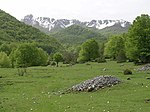
|
several sites | 2017 | 1133ter; ix (naravno) | The primeval beech forests provide an essential resource for understanding the history and evolution of the beech tree (Fagus sylvatica) over the last million years. The site was first listed in 2007 in Slovakia and Ukraine. It was extended in 2011, 2017, and 2021 to include forests in a total of 18 countries. The 13 forests listed in Italy were inscribed in 2017 and 2021. Val Fondillo is pictured.[63] |
| Venetian Works of Defence between the 16th and 17th centuries: Stato da Terra – Western Stato da MarPredloga:Asterisk | 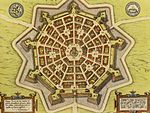
|
Bergamo, Udine, Verona | 2017 | 1533; iii, iv (kulturno) | This property consists of six components of defence works in Italy, Croatia, and Montenegro, spanning more than 1.000 km (620 mi) between the Lombard region of Italy and the eastern Adriatic Coast. The design of the fortifications (termed alla moderna) was marked by the introduction of gunpowder to warfare, which led to significant shifts in military techniques and architecture. Three sites are listed in Italy: the star fort of Palmanova (map pictured) and the fortifications of Bergamo and Peschiera del Garda.[64] |
| Ivrea, Industrial City of the 20th Century | 
|
Metropolitan City of Turin | 2018 | 1538bis; iv (kulturno) | The Industrial City of Ivrea was founded in 1908 by Camillo Olivetti, head of the company Olivetti S.p.A. that produced typewriters, mechanical calculators, and office computers. The city was, mostly between 1930 and the 1960s, designed in line with the ideas of the political Community Movement. The complex includes industrial, residential, and public buildings, and expresses a modern vision of the relationship between industrial production and architecture. A minor boundary modification took place in 2021.[65] |
| The Prosecco Hills of Conegliano and Valdobbiadene. ("Le Colline del Prosecco di Conegliano e Valdobbiadene") | 
|
Treviso | 2019 | 1571rev; v (kulturno) | The cultural landscape of Conegliano and Valdobbiadene is characterized by hogback hills (ciglioni) that have been terraced and converted to vineyards since the 17th century. The region produces the Prosecco wine. The landscape also includes forests, hedges, farms, and villages.[66] |
| The Great Spa Towns of EuropePredloga:Asterisk | 
|
Pistoia | 2021 | 1613; ii, iii, iv, vi (cultural) | The Great Spa Towns of Europe comprises 11 spa towns in seven European countries where mineral waters were used for healing and therapeutic purposes before the development of industrial medication in the 19th century. The town of Montecatini Terme is listed in Italy.[67] |
| Padua's fourteenth-century fresco cycles | 
|
Padua | 2021 | 1623; ii (kulturno) | The site comprises eight buildings, both religious and secular, in four clusters. They house fresco cycles that were painted between 1302 and 1397 by several prominent painters: Giotto, Guariento di Arpo, Giusto de' Menabuoi, Altichiero da Zevio, Jacopo d'Avanzi, and Jacopo da Verona. The frescos are innovative in their way of depicting allegorical narrative and use new techniques of perspective. The Scrovegni Chapel is pictured.[68] |
| The Porticoes of Bologna | 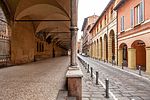
|
Metropolitan City of Bologna | 2021 | 1650; iv (kulturno) | Porticoes represent an important cultural and architectural heritage of the city of Bologna. For centuries, they have been used as sheltered walkways and as prime locations for merchant activities. They were constructed in wood, brick, stone, and in the 20th century also in reinforced concrete. Sometimes they cover both sides of the street. Twelve portico complexes are listed.[69] |
| Evaporitic Karst and Caves of Northern Apennines | 
|
several sites | 2023 | 1692; viii (naravno) | This site comprises four areas with evaporite karst, two with Triassic anhydrites, and two with Messinian gypsum (example from the Gessi Bolognesi Park pictured). There are over 700 caves that exhibit a wide variety of karst features and contain rare minerals. They are also inhabited by several plant species, many of which are endangered.[70][71] |
Sklici[uredi | uredi kodo]
- ↑ »The World Heritage Convention«. UNESCO World Heritage Centre. Arhivirano iz spletišča dne 27. avgusta 2016. Pridobljeno 7. julija 2019.
- ↑ »Convention Concerning the Protection of the World Cultural and Natural Heritage«. UNESCO World Heritage Centre. Arhivirano iz spletišča dne 1. februarja 2021. Pridobljeno 3. februarja 2021.
- ↑ »Italy«. UNESCO World Heritage Centre. Arhivirano iz spletišča dne 1. decembra 2021. Pridobljeno 5. junija 2024.
- ↑ »World Heritage List«. UNESCO World Heritage Centre. Arhivirano iz spletišča dne 2. novembra 2020. Pridobljeno 20. decembra 2021.
- ↑ »Report of the Rapporteur«. UNESCO World Heritage Centre. 30. november 1979. Arhivirano iz spletišča dne 5. julija 2020. Pridobljeno 12. julija 2014.
- ↑ »UNESCO World Heritage Centre – The Criteria for Selection«. UNESCO World Heritage Centre. Arhivirano iz spletišča dne 12. junija 2016. Pridobljeno 17. avgusta 2018.
- ↑ »Rock Drawings in Valcamonica«. UNESCO World Heritage Centre. Arhivirano iz spletišča dne 3. julija 2010. Pridobljeno 26. junija 2010.
- ↑ Emmanuel Anati. »The Way of Life Recorded in the Rock Art of Valcamonica« (PDF). Tanum Museum of Rock Carvings. Arhivirano (PDF) iz spletišča dne 28. novembra 2021. Pridobljeno 24. decembra 2021.
- ↑ »Historic Centre of Rome, the Properties of the Holy See in that City Enjoying Extraterritorial Rights and San Paolo Fuori le Mura«. UNESCO World Heritage Centre. Arhivirano iz spletišča dne 24. februarja 2011. Pridobljeno 26. junija 2010.
- ↑ »Church and Dominican Convent of Santa Maria delle Grazie with "The Last Supper" by Leonardo da Vinci«. UNESCO World Heritage Centre. Arhivirano iz spletišča dne 4. julija 2010. Pridobljeno 26. junija 2010.
- ↑ »Historic Centre of Florence«. UNESCO World Heritage Centre. Arhivirano iz spletišča dne 3. julija 2010. Pridobljeno 26. junija 2010.
- ↑ »Venice and its Lagoon«. UNESCO World Heritage Centre. Arhivirano iz spletišča dne 3. julija 2010. Pridobljeno 26. junija 2010.
- ↑ »Piazza del Duomo, Pisa«. UNESCO World Heritage Centre. Arhivirano iz spletišča dne 2. septembra 2016. Pridobljeno 26. junija 2010.
- ↑ »Decision – 31COM 8B.61 – Nomination of natural, mixed and cultural properties to the world heritage list – Piazza del Duomo, Pisa«. UNESCO World Heritage Centre. Arhivirano iz spletišča dne 8. novembra 2011. Pridobljeno 26. junija 2010.
- ↑ »Historic Centre of San Gimignano«. UNESCO World Heritage Centre. Arhivirano iz spletišča dne 4. julija 2010. Pridobljeno 26. junija 2010.
- ↑ »The Sassi and the Park of the Rupestrian Churches of Matera«. UNESCO World Heritage Centre. Arhivirano iz spletišča dne 4. julija 2010. Pridobljeno 26. junija 2010.
- ↑ »City of Vicenza and the Palladian Villas of the Veneto«. UNESCO World Heritage Centre. Arhivirano iz spletišča dne 3. julija 2010. Pridobljeno 26. junija 2010.
- ↑ »Decision – 20COM VIII.C – Extension and Change of Name: The City of Vicenza and the Palladian Villas of the Veneto (Italy)«. UNESCO World Heritage Centre. Arhivirano iz spletišča dne 27. februarja 2013. Pridobljeno 26. junija 2010.
- ↑ »Historic Centre of Siena«. UNESCO World Heritage Centre. Arhivirano iz spletišča dne 3. julija 2010. Pridobljeno 26. junija 2010.
- ↑ »Historic Centre of Naples«. UNESCO World Heritage Centre. Arhivirano iz spletišča dne 19. maja 2021. Pridobljeno 26. junija 2010.
- ↑ »Crespi d'Adda«. UNESCO World Heritage Centre. Arhivirano iz spletišča dne 4. julija 2010. Pridobljeno 26. junija 2010.
- ↑ »Ferrara, City of the Renaissance, and its Po Delta«. UNESCO World Heritage Centre. Arhivirano iz spletišča dne 4. julija 2010. Pridobljeno 26. junija 2010.
- ↑ »Decision – 23COM VIII.C.2 – Extension: Ferrara, City of the Renaissance and its Po Delta (extension of Ferrara, city of the Renaissance) (Italy)«. UNESCO World Heritage Centre. Arhivirano iz spletišča dne 2. marca 2013. Pridobljeno 26. junija 2010.
- ↑ »Castel del Monte«. UNESCO World Heritage Centre. Arhivirano iz spletišča dne 3. julija 2010. Pridobljeno 26. junija 2010.
- ↑ »The Trulli of Alberobello«. UNESCO World Heritage Centre. Arhivirano iz spletišča dne 3. julija 2010. Pridobljeno 26. junija 2010.
- ↑ »Early Christian Monuments of Ravenna«. UNESCO World Heritage Centre. Arhivirano iz spletišča dne 3. julija 2010. Pridobljeno 26. junija 2010.
- ↑ »Historic Centre of the City of Pienza«. UNESCO World Heritage Centre. Arhivirano iz spletišča dne 4. julija 2010. Pridobljeno 26. junija 2010.
- ↑ »18th-Century Royal Palace at Caserta with the Park, the Aqueduct of Vanvitelli, and the San Leucio Complex«. UNESCO World Heritage Centre. Arhivirano iz spletišča dne 4. julija 2010. Pridobljeno 26. junija 2010.
- ↑ »Residences of the Royal House of Savoy«. UNESCO World Heritage Centre. Arhivirano iz spletišča dne 4. julija 2010. Pridobljeno 26. junija 2010.
- ↑ »Decision – 34COM 8B.58 – Cultural Properties – Examination of minor boundary modifications – Residences of the Royal House of Savoy (Italy)«. UNESCO World Heritage Centre. Arhivirano iz spletišča dne 8. novembra 2011. Pridobljeno 26. junija 2010.
- ↑ »Botanical Garden (Orto Botanico), Padua«. UNESCO World Heritage Centre. Arhivirano iz spletišča dne 4. julija 2010. Pridobljeno 26. junija 2010.
- ↑ »Portovenere, Cinque Terre, and the Islands (Palmaria, Tino and Tinetto)«. UNESCO World Heritage Centre. Arhivirano iz spletišča dne 4. julija 2010. Pridobljeno 26. junija 2010.
- ↑ »Cathedral, Torre Civica and Piazza Grande, Modena«. UNESCO World Heritage Centre. Arhivirano iz spletišča dne 27. decembra 2009. Pridobljeno 26. junija 2010.
- ↑ »Archaeological Areas of Pompei, Herculaneum and Torre Annunziata«. UNESCO World Heritage Centre. Arhivirano iz spletišča dne 4. julija 2010. Pridobljeno 26. junija 2010.
- ↑ »Costiera Amalfitana«. UNESCO World Heritage Centre. Arhivirano iz spletišča dne 4. julija 2010. Pridobljeno 26. junija 2010.
- ↑ »Archaeological Area of Agrigento«. UNESCO World Heritage Centre. Arhivirano iz spletišča dne 7. avgusta 2010. Pridobljeno 26. junija 2010.
- ↑ »Villa Romana del Casale«. UNESCO World Heritage Centre. Arhivirano iz spletišča dne 26. avgusta 2010. Pridobljeno 26. junija 2010.
- ↑ »Su Nuraxi di Barumini«. UNESCO World Heritage Centre. Arhivirano iz spletišča dne 3. julija 2010. Pridobljeno 26. junija 2010.
- ↑ »Archaeological Area and the Patriarchal Basilica of Aquileia«. UNESCO World Heritage Centre. Arhivirano iz spletišča dne 16. decembra 2005. Pridobljeno 26. junija 2010.
- ↑ »Historic Centre of Urbino«. UNESCO World Heritage Centre. Arhivirano iz spletišča dne 19. januarja 2013. Pridobljeno 26. junija 2010.
- ↑ »Cilento and Vallo di Diano National Park with the Archeological sites of Paestum and Velia, and the Certosa di Padula«. UNESCO World Heritage Centre. Arhivirano iz spletišča dne 3. julija 2010. Pridobljeno 26. junija 2010.
- ↑ »Villa Adriana (Tivoli)«. UNESCO World Heritage Centre. Arhivirano iz spletišča dne 20. decembra 2021. Pridobljeno 26. junija 2010.
- ↑ »City of Verona«. UNESCO World Heritage Centre. Arhivirano iz spletišča dne 3. julija 2010. Pridobljeno 26. junija 2010.
- ↑ »Isole Eolie (Aeolian Islands)«. UNESCO World Heritage Centre. Arhivirano iz spletišča dne 3. julija 2010. Pridobljeno 26. junija 2010.
- ↑ »Assisi, the Basilica of San Francesco and Other Franciscan Sites«. UNESCO World Heritage Centre. Arhivirano iz spletišča dne 3. julija 2010. Pridobljeno 26. junija 2010.
- ↑ »Villa d'Este, Tivoli«. UNESCO World Heritage Centre. Arhivirano iz spletišča dne 20. decembra 2021. Pridobljeno 26. junija 2010.
- ↑ »Late Baroque Towns of the Val di Noto (South-Eastern Sicily)«. UNESCO World Heritage Centre. Arhivirano iz spletišča dne 3. julija 2010. Pridobljeno 26. junija 2010.
- ↑ »Sacri Monti of Piedmont and Lombardy«. UNESCO World Heritage Centre. Arhivirano iz spletišča dne 2. aprila 2011. Pridobljeno 26. junija 2010.
- ↑ »Val d'Orcia«. UNESCO World Heritage Centre. Arhivirano iz spletišča dne 4. julija 2010. Pridobljeno 26. junija 2010.
- ↑ »Etruscan Necropolises of Cerveteri and Tarquinia«. UNESCO World Heritage Centre. Arhivirano iz spletišča dne 3. julija 2010. Pridobljeno 26. junija 2010.
- ↑ »Syracuse and the Rocky Necropolis of Pantalica«. UNESCO World Heritage Centre. Arhivirano iz spletišča dne 4. julija 2010. Pridobljeno 26. junija 2010.
- ↑ »Genoa: Le Strade Nuove and the system of the Palazzi dei Rolli«. UNESCO World Heritage Centre. Arhivirano iz spletišča dne 21. junija 2010. Pridobljeno 26. junija 2010.
- ↑ »Rhaetian Railway in the Albula / Bernina Landscapes«. UNESCO World Heritage Centre. Arhivirano iz spletišča dne 2. marca 2012. Pridobljeno 10. decembra 2020.
- ↑ »Mantua and Sabbioneta«. UNESCO World Heritage Centre. Arhivirano iz spletišča dne 28. oktobra 2010. Pridobljeno 26. junija 2010.
- ↑ »The Dolomites«. UNESCO World Heritage Centre. Arhivirano iz spletišča dne 4. julija 2010. Pridobljeno 26. junija 2010.
- ↑ »Monte San Giorgio«. UNESCO World Heritage Centre. Arhivirano iz spletišča dne 6. februarja 2012. Pridobljeno 10. decembra 2020.
- ↑ »Longobards in Italy. Places of the power (568–774 A.D.)«. UNESCO World Heritage Centre. Arhivirano iz spletišča dne 30. junija 2011. Pridobljeno 26. junija 2010.
- ↑ »Prehistoric Pile Dwellings Around the Alps«. UNESCO World Heritage Centre. Arhivirano iz spletišča dne 3. oktobra 2020. Pridobljeno 10. decembra 2020.
- ↑ »Medici Villas and Gardens in Tuscany«. UNESCO World Heritage Centre. Arhivirano iz spletišča dne 20. avgusta 2013. Pridobljeno 4. avgusta 2013.
- ↑ »Mount Etna«. UNESCO World Heritage Centre. Arhivirano iz spletišča dne 6. avgusta 2013. Pridobljeno 4. avgusta 2013.
- ↑ »Vineyard Landscape of Piedmont: Langhe-Roero and Monferrato«. UNESCO World Heritage Centre. Arhivirano iz spletišča dne 28. julija 2014. Pridobljeno 29. julija 2014.
- ↑ »Arab-Norman Palermo and the Cathedral Churches of Cefalú and Monreale«. UNESCO World Heritage Centre. Arhivirano iz spletišča dne 17. decembra 2021. Pridobljeno 18. decembra 2021.
- ↑ »Ancient and Primeval Beech Forests of the Carpathians and Other Regions of Europe«. UNESCO World Heritage Centre. Arhivirano iz spletišča dne 2. marca 2012. Pridobljeno 7. septembra 2017.
- ↑ »Venetian Works of Defence between the 16th and 17th Centuries: Stato da Terra – Western Stato da Mar«. UNESCO World Heritage Centre. Arhivirano iz spletišča dne 6. septembra 2017. Pridobljeno 30. avgusta 2017.
- ↑ »Ivrea, industrial city of the 20th century«. UNESCO. Arhivirano iz spletišča dne 27. novembra 2021. Pridobljeno 26. decembra 2019.
 Članek vsebuje besedilo iz tega vira, ki je v javni domeni.
Članek vsebuje besedilo iz tega vira, ki je v javni domeni.
- ↑ »The Prosecco Hills of Conegliano and Valdobbiadene«. UNESCO. Arhivirano iz spletišča dne 7. oktobra 2020. Pridobljeno 23. septembra 2019.
- ↑ »The Great Spa Towns of Europe«. UNESCO World Heritage Centre. Arhivirano iz spletišča dne 28. julija 2021. Pridobljeno 1. avgusta 2021.
- ↑ »Padua's fourteenth-century fresco cycles«. UNESCO World Heritage Centre. Arhivirano iz spletišča dne 24. julija 2021. Pridobljeno 27. decembra 2021.
- ↑ »The Porticoes of Bologna«. UNESCO World Heritage Centre. Arhivirano iz spletišča dne 18. decembra 2021. Pridobljeno 27. decembra 2021.
- ↑ »Evaporite karst and caves of Emilia Romagna Region«. UNESCO World Heritage Centre. Arhivirano iz spletišča dne 3. decembra 2021. Pridobljeno 1. januarja 2022.
- ↑ »Evaporitic Karst and Caves of Northern Apennines«. UNESCO World Heritage Centre. Pridobljeno 20. septembra 2023.


